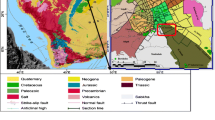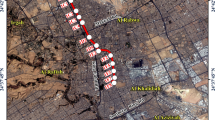Abstract
Hydraulic conductivities of rock masses in Tunçbilek lignite basin, western Turkey, were determined by analytical methods and seepage analyses. In situ hydraulic conductivity of lignite, clay-bearing rocks and disturbed rock masses in the basin was determined by utilizing the inversed auger hole method. The hydraulic conductivity values of the lignite and clay-bearing rocks were determined by the field testing to be ranged from 7.88×10−7 to 2.24×10−6 m/s and from 2.49×10−7 to 1.11×10−5 m/s, respectively. Excavation and blasting processes for mining activity eventually caused a significant increase in the fracture frequency. Therefore, hydraulic conductivity values of disturbed/blasted rock masses were measured as two or three order magnitudes higher than those measured on the undisturbed clay-bearing rock masses. To get a further understanding of the hydraulic properties of studied rock masses, seepage analyses were also performed on rock masses left as a pillar between an underground mining gallery and an adjacent abandoned open-pit mining lake. According to the analytical solution based on the Dupuit-Forchheimer approximations, the average hydraulic conductivity value of the pillar consisting mainly of marls, claystone and lignite layer with a variable thickness was calculated as 1.2×10−6 m/s. Seepage analyses were also performed to predict water inflow to the gallery in the case of possible blasting and subsidence-related disturbance problems as well as a rise in the level of the open-pit lake. Based on the results obtained, it can be concluded that subsidence or blasting-induced disturbance of rock masses can cause excessive water inflow into the underground galleries to jeopardize the safety of mining activities.











Similar content being viewed by others
References
Alemdag S (2015) Assessment of bearing capacity and permeability of foundation rocks at the Gumustas Waste Dam Site, (NE Turkey) using empirical and numerical analysis. Arab J Geosci 8:1099–1110. https://doi.org/10.1007/s12517-013-1236-3
Baş H (1986) Tertiary geology of the Domaniç-Tavşanlı-Kütahya-Gediz region. Jeoloji Mühendisliği 17:11–18
Black JH (1987) Flow and flow mechanisms in crystalline rock. In: Goff JC, Williams BPJ (eds) Fluid Flow in Sedimentary Basins and Aquifers, vol 34. Geological Society Special Publications, London, pp 186–200
Blümling P, Bernier F, Lebon P, Martin CD (2007) The excavation damaged zone in clay formations time-dependent behavior and influence on performance assessment. Phys Chem Earth 32:588–599. https://doi.org/10.1016/j.pce.2006.04.034
Burgess A (1977) Groundwater movements around a repository - regional groundwater flow analyses. Kaernbraenslesaekerhet, Stockholm
Carlsson A, Olsson T (1977) Hydraulic properties of Swedish crystalline rocks-hydraulic conductivity and its relation to depth. Bulletin of the Geological Institutions of the University of Uppsala 7:71–84
Çelik Y (2000) Stratigraphy and depositional environments of the Domaniç (Kütahya) Neogene basin, western Turkey. In: 53rd Geological Congress of Turkey, Abstract Book, Ankara, pp 177–178
Demir H, Bozdağ Ş (2020) Determination of the permeability properties of the Gyttja in the section Kahramanmaraş-Afşin-Elbistan coal basin and evaluation in the terms of dewatering. Çukurova Univ J Sci Eng 39(4):91–102
Fell R, MacGregor P, Stapledon D, Bell G (2005) Geotechnical Engineering of Dams. Taylor & Francis, London
Fernandez G, Moon J (2010) Excavation-induced hydraulic conductivity reduction around a tunnel-part 1: guideline for estimate of groundwater inflow rate. Tunn Undergr Space Technol 25:560–566. https://doi.org/10.1016/j.tust.2010.03.006
Foyo A, Sánchez MA, Tomillo C (2005) A proposal for a secondary permeability index obtained from water pressure tests in dam foundations. Eng Geol 77(1):69–82. https://doi.org/10.1016/j.enggeo.2004.08.007
Ghaffari HO, Sharifzadeh M, Shahriar K, Pedrycz W (2009) Application of soft granulation theory to permeability analysis. Int J Rock Mech Min Sci 46(3):577–589. https://doi.org/10.1016/j.ijrmms.2008.09.001
Groenewold GH, Hemish LA, Cherry JA, Rehm BW, Meyer GN, Winczewski LM (1979) Geology and geohydrology of the Knife River basin and adjacent areas of west-central North Dakota. North Dakota Geological Survey Reports of Investigation Number 64
Gurocak Z, Alemdag S (2012) Assessment of permeability and injection depth at the Atasu dam site (Turkey) based on experimental and numerical analyses. Bull Eng Geol Environ 71:221–229. https://doi.org/10.1007/s10064-011-0400-9
Hamm SY, Kim M, Cheng JY, Kim JY, Son M, Kim TW (2007) Relationship between hydraulic conductivity and fracture properties estimated from packer test and borehole data in a fracture granite. Eng Geol 92:73–87. https://doi.org/10.1016/j.enggeo.2007.03.010
Ku CY, Hsu SM, Chiou LB, Lin GF (2009) An empirical model for estimating hydraulic conductivity of highly disturbed clastic sedimentary rocks in Taiwan. Eng Geol 109:213–223. https://doi.org/10.1016/j.enggeo.2009.08.008
Louis C (1972) Rock hydraulics. In: Muller L (ed) Rock mechanics. Springer Verlag, Vienna, pp 299–387
Louis C, Maini YN (1970) Determination of in-situ hydraulic parameters in jointed rock. Int Soc Rock Mech Proc 1:1–19
Lugeon M (1933) Barrage et Géologie. Dunod, Paris
Moran SR, Groenewold GH, Cherry JA (1978) Geologic, hydrologic, and geochemical concepts and techniques in overburden characterization for mined-land reclamation. North Dakota Geological Survey Reports of Investigation Number 63
MTA (2002) 1:500,000 scale geology map of Turkey, İzmir sheet. General Directorate of MTA, Ankara
Oosterband R, Nijland H (1994) Determining the saturated hydraulic conductivity. In: Ritzema HP (ed) Drainage Principles and Applications, 2nd edn. Wageningen, ILRI, pp 435–476
Pesendorfer M, Loew S, Zappa M (2009) Environmental impacts of the Lötschberg Base and Crest Tunnels, Switzerland. In: Vrkljan I (ed) Rock Engineering in Difficult Ground Conditions – Soft Rocks and Karst (Eurock 2009). CRC Press, pp 729–734
Quiñones-Rozo C (2010) Lugeon test interpretation, revisited. US Society of Dams, 30th Annual Conference, Sacremento, April 12-16, 2010, pp 405–414
Rehm BW, Groenewold GH, Morin KA (1980) Hydraulic properties of coal and related materials, Northern Great Plains. Ground Water 18(6):551–561
Schobert HH (1995) Lignites of North America. Elsevier, Amsterdam
Shestopalov V, Rudenko Y (2002) Radioactive contamination of groundwater within Kiev conurbation. In: Shestopalov V (ed) Chernobyl Disaster and Groundwater. A.A. Balkema Publisher, pp 101–132
Singhal BBS, Gupta RP (2010) Applied hydrogeology of fractured rocks, 2nd edn. Springer, Dordrecht
van Hoorn JW (1979) Determining hydraulic conductivity with the inversed auger hole and infiltrometer methods. In: Wesseling J (ed) Proc. Int. Drainage Workshop, Wageningen, pp 150–154
Wei ZQ, Egger P, Descoeudres F (1995) Permeability predictions for jointed rock masses. Int J Rock Mech Min Sci Geomech Abstr 32:251–261
Xu Z, Zhao Z, Sun J, Lu M (2015) Determination of hydraulic conductivity of fractured rock masses: a case study for a rock cavern project in Singapore. J Rock Mech Geotech Eng 7:178–184. https://doi.org/10.1016/j.jrmge.2014.10.006
Zhao J (1998) Rock mass hydraulic conductivity of the Bukit Timah granite, Singapore. Eng Geol 50:211–216. https://doi.org/10.1016/S0013-7952(98)00021-0
Acknowledgements
The authors gratefully acknowledge the financial support of the Turkish National Coal Board (TCB). The authors are also very grateful to field staffs of the Garp Lignite Operations Directorate for their valuable logistical support during field studies. The authors also thank the reviewers for their valuable comments and suggestions which improved the manuscript.
Author information
Authors and Affiliations
Corresponding author
Ethics declarations
Competing interest
The authors declare no competing interests.
Additional information
Responsible editor: Amjad Kallel
Rights and permissions
About this article
Cite this article
Karakuş, H., Erguler, Z.A., Ediz, İ.G. et al. Assessment of hydraulic conductivity of disturbed and undisturbed rock masses in Tunçbilek lignite basin, Turkey. Arab J Geosci 14, 1522 (2021). https://doi.org/10.1007/s12517-021-08063-6
Received:
Accepted:
Published:
DOI: https://doi.org/10.1007/s12517-021-08063-6




